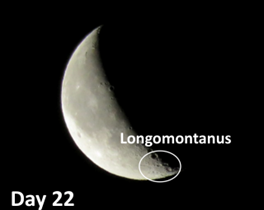The week of February 13-19 takes us from Lunar Day 22 to Day 29. This week we will highlight the moon crater Longomontanus, located in the SW quadrant of the Field Map and viewable on Tuesday night.
 Longomontanus: [SW/P7; L=22°W] Take a look at Longomontanus and before reading further, decide if something seems slightly “wrong” about this moon crater.
Longomontanus: [SW/P7; L=22°W] Take a look at Longomontanus and before reading further, decide if something seems slightly “wrong” about this moon crater.
Longomontanus is an exception to the rule that moon crater age can be determined by their relative sizes. Larger moon craters are almost always older, and when there’s an overlap, smaller moon craters will intrude upon the rims and floors of their larger and older cousins. The east rim of Longomontanus has superimposed itself on top of what is obviously an older, but smaller, moon crater.
OF ADDITIONAL INTEREST IN SPACE
 On Wednesday, Venus is only 0.01° south of Neptune, and Jupiter is 1.2° north of the Moon.
On Wednesday, Venus is only 0.01° south of Neptune, and Jupiter is 1.2° north of the Moon.
======================
It is highly recommended that you get a copy of Sky and Telescope’s Field Map of the Moon, the very finest Moon map available for use at the telescope. It is available for $10.95 at www.skyandtelescope.com and on Amazon. All features mentioned in this blog will be keyed to the grid on the Field Map and will look like this: Plato: [NW/D9]
Credits:
Courtesy of Gray Photography of Corpus Christi, Texas
Lunar photos: NASA / USGS / BMDO / LROC / ASU / DLR / LOLA / Moon Globe. Used by permission
- Rupes Cauchy: A Best Known Fault on the Moon - July 22, 2024
- Moon Crater Schickard – Crater Floor has Stripes - July 15, 2024
- Moon Craters Langrenus and Vandelinus - July 8, 2024